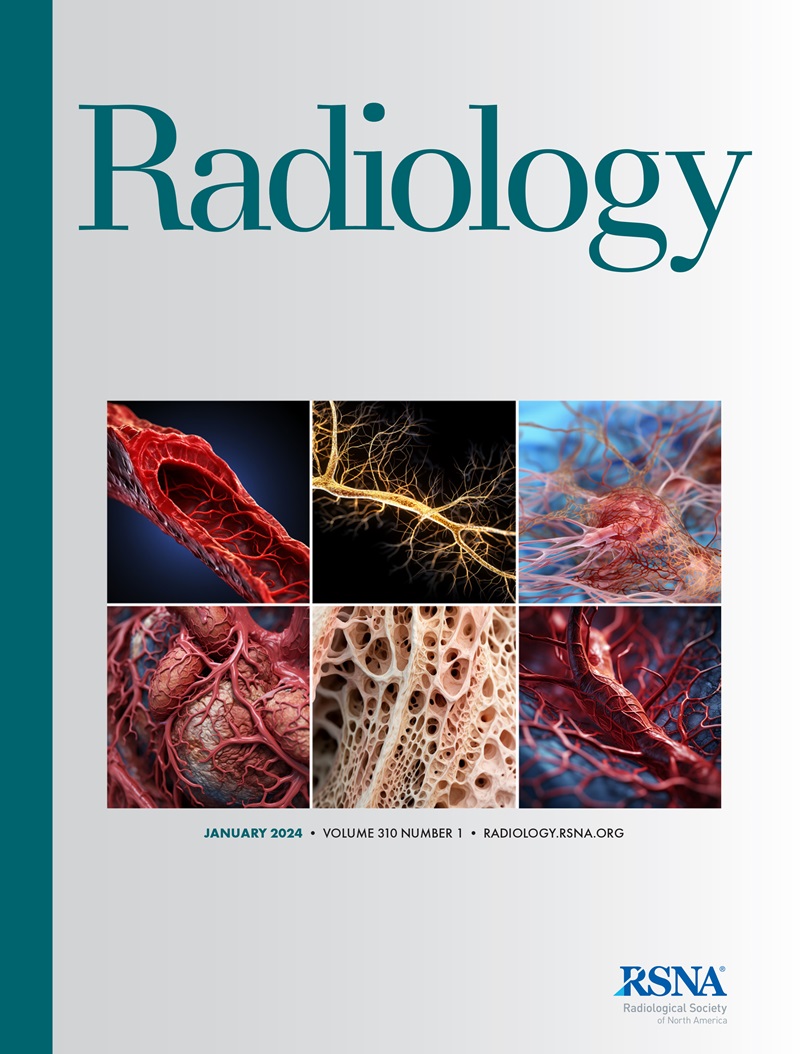CT监测与手术治疗磨玻璃结节10年生存率的比较。
IF 15.2
1区 医学
Q1 RADIOLOGY, NUCLEAR MEDICINE & MEDICAL IMAGING
引用次数: 0
摘要
在持续随访或手术监测期间肺磨玻璃结节(ggn)体积增大,是否应进行治疗的争论在临床实践中提出了挑战。目的:为ggn的长期生存和监测的适当性提供基于证据的见解,特别是那些在随访期间体积增加的ggn。材料与方法本前瞻性研究纳入2005年3月至2013年12月在中国国家癌症中心CT检查中发现ggn的患者,随访至2024年5月。初步分析比较了所有ggn、稳定ggn和体积增大的ggn个体的总生存期(OS)。次要结果是无复发生存,由病理结果或临床放射学一致证实。并对手术费用和手术时间进行分析。在比较组间结果时,使用倾向评分匹配来平衡基线特征。多变量Cox比例风险模型用于确定校正风险比和95% ci。结果684例患者(中位年龄56岁,IQR 49 ~ 62岁,女性434例)共检测到1003个ggn;其中,40个个体的优势ggn发展为固体组分,644个个体保持ggn的状态。其中,207例(32.1%)接受了手术。观察组与手术组10年OS无差异(94.7% [95% CI: 92.2, 97.2] vs 97.6% [95% CI: 95.3, 100]; P = .10)。多变量调整后,在ggn患者(风险比0.56 [95% CI: 0.18, 1.78]; P = 0.33)、ggn增大患者(风险比0.78 [95% CI: 0.15, 4.17]; P = 0.78)和ggn稳定患者(风险比0.29 [95% CI: 0.03, 3.00]; P = 0.30)中,没有证据表明手术与10年OS存在关联。在31例稳定的ggn患者和48例增大的ggn患者的7年无复发生存率中也没有观察到差异(100% vs 100%, P < 0.99)。没有证据表明GGN大小的增加会影响手术费用(8401.5美元vs 8388.5美元,P = 0.79)或持续时间(2.0小时vs 2.0小时,P = 0.99)。结论对于ggn,没有证据表明监测和手术之间的长期生存率有显著差异,也没有证据表明随访期间稳定和增大的ggn之间的长期生存率有显著差异。因此,CT监测可能适合于ggn,直到出现固体成分。©RSNA, 2025本文可获得补充材料。参见Hammer在本期的社论。本文章由计算机程序翻译,如有差异,请以英文原文为准。
Comparison of 10-year Survival Outcomes between CT Surveillance and Surgery for Ground-Glass Nodules.
Background The debate over whether to manage pulmonary ground-glass nodules (GGNs) that increase in size during surveillance with continued follow-up or surgery poses challenges in clinical practice. Purpose To provide evidence-based insights into the long-term survival and appropriateness of surveillance for GGNs, particularly those that increase in size during follow-up. Materials and Methods In this prospective study, patients with GGNs detected at CT examinations between March 2005 and December 2013 were included at the National Cancer Center, China, and followed up until May 2024. The primary analysis compared overall survival (OS) between the surveillance and surgery groups among all individuals with GGNs, stable GGNs, and GGNs that increased in size. The secondary outcome was recurrence-free survival, confirmed with either pathologic findings or clinical-radiologic consensus. Cost and duration of surgery were also analyzed. Propensity score matching was used to balance baseline characteristics when comparing outcomes between groups. Multivariable Cox proportional hazard models were used to determine adjusted hazard ratios and 95% CIs. Results A total of 1003 GGNs in 684 individuals (median age, 56 years; IQR, 49-62 years; 434 female) were evaluated; among them, 40 individuals had dominant GGNs that developed solid components, whereas 644 individuals maintained their status as GGNs. Of these, 207 (32.1%) underwent surgery. There was no evidence of a difference observed in 10-year OS between surveillance and surgery groups (94.7% [95% CI: 92.2, 97.2] vs 97.6% [95% CI: 95.3, 100], respectively; P = .10). After multivariable adjustment, there was no evidence of an association between surgery and 10-year OS in those with GGNs (hazard ratio, 0.56 [95% CI: 0.18, 1.78]; P = .33), those with GGNs that increased in size (hazard ratio, 0.78 [95% CI: 0.15, 4.17]; P = .78), and those with stable GGNs (hazard ratio, 0.29 [95% CI: 0.03, 3.00]; P = .30). There was also no evidence of a difference observed in 7-year recurrence-free survival between 31 individuals with stable GGNs and 48 individuals with GGNs that increased in size (100% vs 100%, P > .99). There was no evidence that increased GGN size affected surgical cost ($8401.5 vs $8388.5, P = .79) or duration (2.0 vs 2.0 hours, P > .99). Conclusion For GGNs, there was no evidence of significant differences in long-term survival between surveillance and surgery or between stable and increased size during follow-up. Therefore, CT surveillance may be appropriate for GGNs until a solid component emerges. © RSNA, 2025 Supplemental material is available for this article. See also the editorial by Hammer in this issue.
求助全文
通过发布文献求助,成功后即可免费获取论文全文。
去求助
来源期刊

Radiology
医学-核医学
CiteScore
35.20
自引率
3.00%
发文量
596
审稿时长
3.6 months
期刊介绍:
Published regularly since 1923 by the Radiological Society of North America (RSNA), Radiology has long been recognized as the authoritative reference for the most current, clinically relevant and highest quality research in the field of radiology. Each month the journal publishes approximately 240 pages of peer-reviewed original research, authoritative reviews, well-balanced commentary on significant articles, and expert opinion on new techniques and technologies.
Radiology publishes cutting edge and impactful imaging research articles in radiology and medical imaging in order to help improve human health.
 求助内容:
求助内容: 应助结果提醒方式:
应助结果提醒方式:


